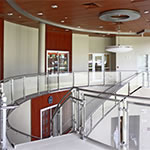The Pelham Range Armed Forces Reserve Center (AFRC), a facility for logistics, weapons, and unit administration training in Alexandria, Alabama, is the state’s first LEED Platinum building for military training and a model for sustainable construction. LEED Silver is required for all new National Guard projects, but for Pelham Range, leadership wanted to go as green as possible while staying within the project budget, a decision that reflects the military’s growing comfort with LEED certification. “In recent years, they’ve been driven to deliver the highest level of sustainability,” says JMR+H Architecture’s Michael Rutland, who helped design the building. “We developed Pelham Range AFRC based on that mission. We didn’t have to convince them to go LEED Platinum, but we did have to prove we could do it without a high degree of associated cost.” Here’s how they did it.
![“We didn’t have to convince [the National Guard] to go LEED Platinum, but we did have to prove we could do it without a high degree of associated cost," says Michael Rutland of JMR+H on Pelham Range.](https://gbdtest.wpengine.com/wp-content/uploads/2014/06/IMG_8381Rev-240x400.jpg)
“We didn’t have to convince [the National Guard] to go LEED Platinum, but we did have to prove we could do it without a high degree of associated cost,” says Michael Rutland of JMR+H on Pelham Range.
Checking the List
JMR+H reviews all projects at various stages throughout the design process to ensure that they are meeting LEED criteria. When a project is approximately 50 percent complete, JMR+H holds a meeting dedicated to LEED certification and development. The Pelham Range project received 53 out of 69 possible points and earned all innovation and design credits, with three achieved through exemplary performance. The project also earned five out of six credits identified by USGBC Regional Councils as particularly important for the Alexandria area.
Energy Efficiency
The building achieves an energy cost savings of 38 percent, thanks to an improved thermal envelope, reduced interior lighting power density, occupancy sensors, high-efficiency geothermal pumps, and on-site renewable energy. (A photovoltaic array generates 12 percent of the center’s energy.) The estimated 20-year life-cycle savings through sustainable technologies, strategies, and design is $80,000.
Sourcing Sustainably
Leadership within the Alabama Army National Guard and Alabama Army Reserve, who jointly own the AFRC, largely supported sourcing sustainable materials. Thirty percent of building materials by value was manufactured using recycled materials, which qualified for an innovation and design credit for exemplary performance. More than a third of the materials were obtained within 500 miles of the project site.
Protective Measures
Finding the right areas of the building for daylighting was a challenge because of the need to maximize security through Anti-Terrorism Force Protection design. Rutland found a solution by installing a series of high interior windows, placed well above the sightline to help bring in daylight. Translucent window-walls in security-sensitive areas allow filtered natural light and preserve the safety in these areas. Although the use of natural light was extensive for a building of this kind, it wasn’t enough to earn a LEED credit for daylighting.

